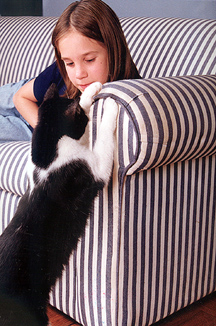Ouch! Step out of bed and your unsuspecting toes become moving victims, perfect prey for an early-rising cat waiting to pounce. Squeal, jump, run – and the game is on. While this may be great fun for your cat, its probably not fun for you. Here are some practical suggestions for coping with cats that like to attack hands and feet.
Kittens and cats need the opportunity to play, says Emily Levine, DVM, animal behavior resident at the Cornell University Hospital for Animals Animal Behavior Clinic at the College of Veterinary Medicine. From a kittens point of view, human hands and feet are attractive objects to play with, because fingers and toes move, wiggle and withdraw quickly.
How the Problem Starts
At first, most people think its cute when playful kittens grab their fingers, so cat owners inadvertently reinforce the behavior, Dr. Levine says. Its normal kitten behavior but when a cat gets older his teeth get bigger, his jaws become stronger, and pain is a factor. The cat continues the behavior because hes been taught from a young age that its okay to do, she explains.
Our human reactions dont help. In an ideal world there would be no moving or screaming, but most people being attacked naturally move and scream [which contributes to the cats excitement], she adds.
The good news is that most of this behavior can be redirected, Dr. Levine says. If hands or feet are your cats favorite target, try the following expert tips.


216
Bait and switch. To stop unpleasant feline play behavior, replace it with something else your cat enjoys. Cats need some form of play, so its important to ensure he has the opportunity to sharpen skills, hone reflexes, and release energy in appropriate ways.
Provide hair-raising toys and rotate them. Most cats like to play with moving objects, so trade your fingers and toes for toys that move. The traditional fishing wand still works wonders – allowing you to interact with your cat at arms length. One mouse-shaped toy with a wand tail provides motorized excitement at different speeds. Or simply try tossing a Ping-Pong ball for your cat to chase (or on the floor before you step out of bed).
You can also hide food treats so your cat can hunt for them. A popular commercial toy makes your kitty work for the rewarding treats you hide inside it. Experiment to find out what your cat enjoys most.
Schedule playtime. Finding it hard to carve out time for your cat? We recommend that clients schedule play times with their cats at least twice a day, for a minimum of five minutes for each play session, Dr. Levine advises. Dont be surprised if both you and your cat look forward to this short, satisfying time together.
Be there. Many cats like to play in the presence of their human companions, Dr. Levine notes. Sometimes you have work to do, though, and you cant stop to play with your cat, she says. Simply placing a toy near you on the floor as you work on the computer may satisfy your cats need to play.
Create vertical space. Cats love to explore the upside of their world. Expanding your cats vertical space is a great way to enrich her environment. Dramatically increasing feline space can be as simple as putting up a wooden shelf for your cat to climb on, or you can choose more elaborate designs. (For inspiration, visit the ultimate home catwalk at http://www.pix.tv/.)
Dont punish him for pouncing on hands or feet. People often try punishment techniques that scare a cat, which only makes things worse, Dr. Levine says. A mother cat teaches her kittens to inhibit their bites; she would actually kick, bite, or try and move an attacking kitten away, but we cant do that. People cannot communicate in the same way a mother cat would to a kitten, she explains.
Wind her down. Dont leave your cat wide-eyed and ready for more action. A slow tone of voice and a key word can signal the end of play.
To end a play session, redirect your cat to something else she likes, suggests Dr. Levine. For example, if your cat loves treats, get her mind off playing by giving her a lick of baby food or another healthy treat.
Finally, seek an animal behaviorist if your cat exhibits aggressive behavior toward you, Dr. Levine emphasizes. Cats that cross the line initially intend to play – exhibiting play behaviors – but when you try and stop they may approach you aggressively, almost as if a light switch goes on, she explains.
One temporary measure can help diffuse this situation. For seriously aggressive cats we usually recommend that cat owners keep cardboard boxes in each room of the house, Dr. Levine says. They can hold up the box to protect themselves, and then put the box over the cat to safely scoot him to another room. Then remove the box and shut the door, so the cat can have some quiet time to calm down.



